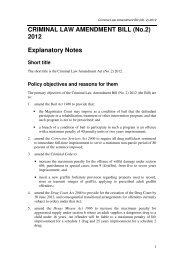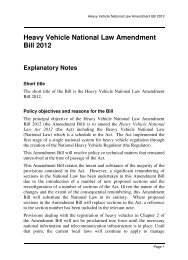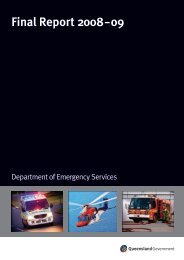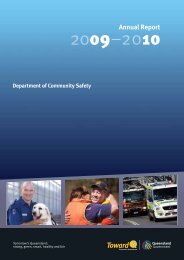Keeping it real - the Queensland VET Development Centre
Keeping it real - the Queensland VET Development Centre
Keeping it real - the Queensland VET Development Centre
- No tags were found...
Create successful ePaper yourself
Turn your PDF publications into a flip-book with our unique Google optimized e-Paper software.
A common practice in TAFE inst<strong>it</strong>utes, according to those consulted, seems to involve dividing <strong>the</strong> 10days into 5 days for industry currency, 2 days for <strong>the</strong> whole-of-inst<strong>it</strong>ute staff development days, w<strong>it</strong>h<strong>the</strong> remaining days available for o<strong>the</strong>r professional development. Some respondents reported that<strong>the</strong> whole-of-inst<strong>it</strong>ute staff development days covered generic topics which do not directly contributeto professional development in training or industry currency. They thought that generic professionaldevelopment should not be attributed to <strong>the</strong> 10 days of professional development. This was because<strong>it</strong> did not meet <strong>the</strong>ir particular training needs for industry currency purposes.Opinions about <strong>the</strong> ideal length and frequency of industry placement varied across vocational trainingareas. Respondents from vocational training areas w<strong>it</strong>h regular industry changes argued that trainersshould undertake industry placement every year in order to maintain <strong>the</strong>ir skills at industry standard.Those from industries w<strong>it</strong>h a slower rate of change thought industry placement could be less frequent,for example every 3 years.There were also differences in opinion about <strong>the</strong> length of time trainers should spend in industryplacements. For example, single days interm<strong>it</strong>tently throughout <strong>the</strong> year were considered appropriatefor service industries, whereas <strong>it</strong> was perceived that blocks of two weeks or more would be best inindustries w<strong>it</strong>h longer term project based work such as construction. A few trainers have soughtlonger placements of six months to a year in industry to improve <strong>the</strong>ir industry knowledge, skills andexperience.Many respondents expressed an interest in undertaking regular industry placements w<strong>it</strong>hin differentworkplaces to experience different market segments w<strong>it</strong>hin <strong>the</strong>ir industry. However for some trainers,particularly those w<strong>it</strong>hout strong industry networks, finding industry placement opportun<strong>it</strong>ies isdifficult.Timing of industry placement is ano<strong>the</strong>r issue for trainers. Some stated that <strong>it</strong> can be difficult to finda time that is convenient to both <strong>the</strong> RTO and <strong>the</strong> industry, particularly when <strong>the</strong> ‘down time’ periodscoincide, for example, <strong>the</strong> building industry and RTO Christmas closure.Key Finding 8Opinions about <strong>the</strong> ideal duration and frequency of industry placement vary.• Industry employmentA number of respondents reported an increased focus by RTO managers on recent industry experienceor part-time industry employment to meet AQTF Element 1.4 industry currency requirements.Respondents maintained <strong>the</strong>re are many ways for trainers to gain industry experience — includingself-employment, working in a family business, part-time or casual employment, using <strong>the</strong>ir networksor even volunteering. However, feedback from <strong>VET</strong> stakeholders indicates that some TAFE managersdo not accept some of <strong>the</strong>se activ<strong>it</strong>ies as relevant to industry currency, particularly where <strong>the</strong>re is aperceived conflict of interest.Attributing <strong>the</strong> trainer’s self-employment as <strong>the</strong> sole source of industry currency was challenged bysome managers. They argue that self-employment provides lim<strong>it</strong>ed opportun<strong>it</strong>ies for exposure tonew ideas, skills and processes — opportun<strong>it</strong>ies that may be available when working in a differentworkplace. As well, <strong>the</strong>y maintain that self-employment does not provide experience in differentmarket segments w<strong>it</strong>hin <strong>the</strong> trainer’s industry area.These considerations were not reported as issues by <strong>the</strong> respondents from private RTOs.10 <strong>Keeping</strong> <strong>it</strong> <strong>real</strong>













